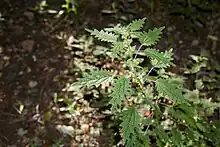| Hesperocnide sandwicensis | |
|---|---|
 | |
| Scientific classification | |
| Kingdom: | Plantae |
| Clade: | Tracheophytes |
| Clade: | Angiosperms |
| Clade: | Eudicots |
| Clade: | Rosids |
| Order: | Rosales |
| Family: | Urticaceae |
| Genus: | Hesperocnide |
| Species: | H. sandwicensis |
| Binomial name | |
| Hesperocnide sandwicensis (Wedd.) Wedd. | |
Hesperocnide sandwicensis, the Hawai'i stingingnettle, is a rare species of nettle endemic to the island of Hawai'i. Less than 1000 plants from only 3 occurrences are estimated to exist due to grazing pressure from invasive sheep, goats, and pigs.[2]
The closest relative of H. sandwicensis, and the only other species in the genus Hesperocnide, is the California endemic Hesperocnide tenella.
Description
Hesperocnide sandwicensis is an annual nettle, growing 20-60cm tall. Leaves and stems are covered in small hairs, with leaves growing 1.5-7cm in length.[3] Unlike other Hawaiian nettles which lost their ability to sting due to a lack of large herbivores, H. sandwicensis has retained this ability and its hairs can provide a painful sting if touched.[4]
Distribution and habitat
Hesperocnide sandwicensis grows only in the understory of subalpine dry forests on the volcanic slopes of Mauna Kea, Mauna Loa, and Hualālai on the big island of Hawai'i.
References
- ↑ "NatureServe Explorer 2.0". explorer.natureserve.org. Retrieved 2023-08-07.
- ↑ "NatureServe Explorer 2.0". explorer.natureserve.org. Retrieved 2023-08-07.
- ↑ "Flora of the Hawaiian Islands - Species Page/ Botany, National Museum of Natural History, Smithsonian Institution". naturalhistory2.si.edu. Retrieved 2023-08-07.
- ↑ "Hesperocnide". Restore Mauna Kea. 2016-02-19. Retrieved 2023-08-07.
